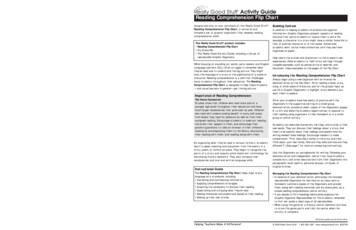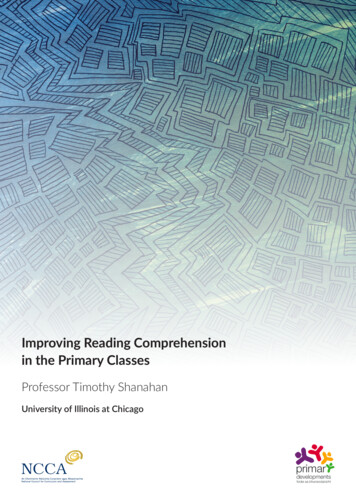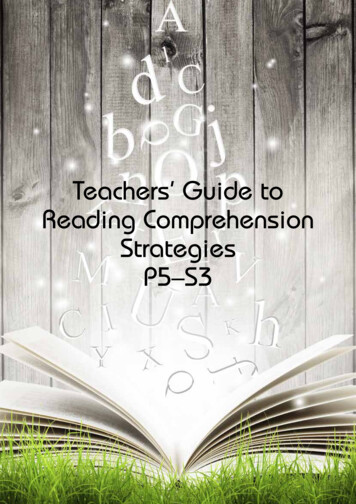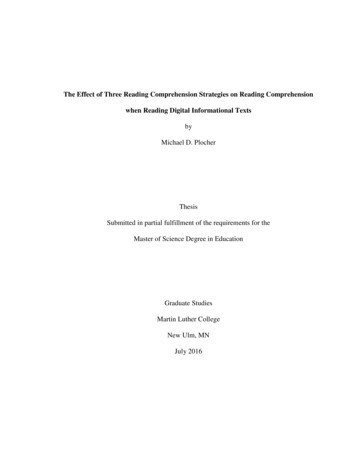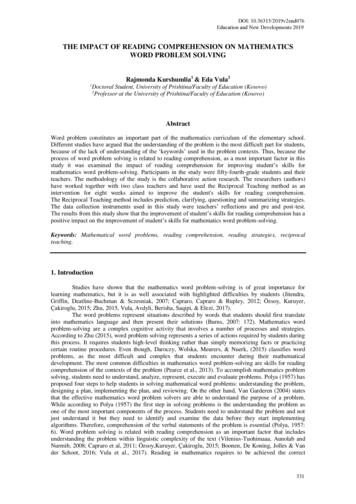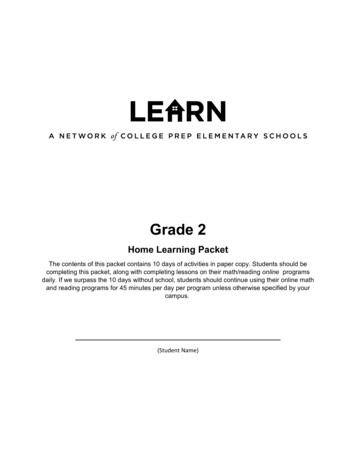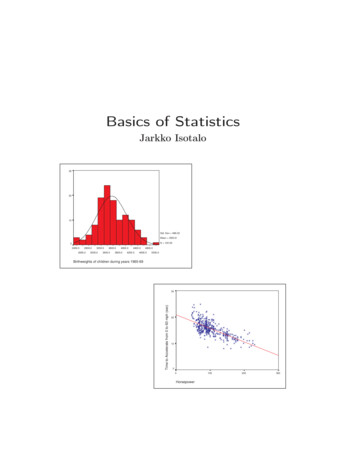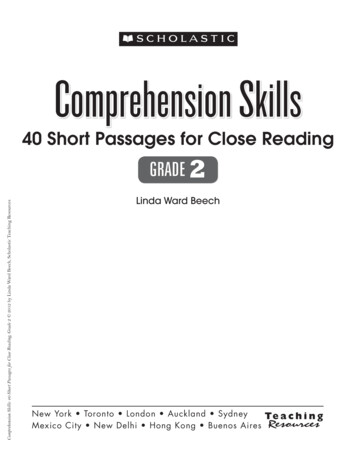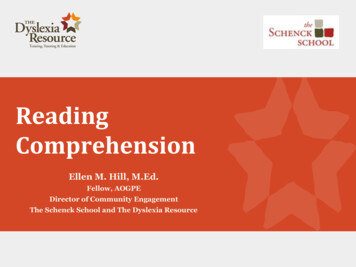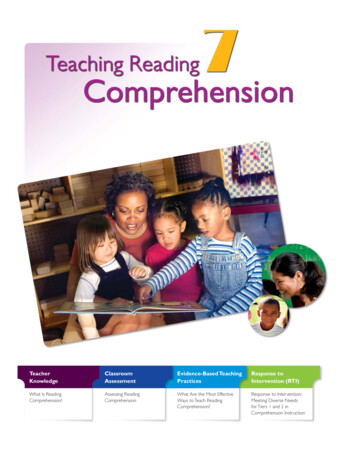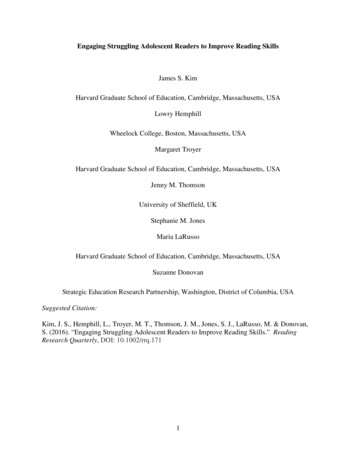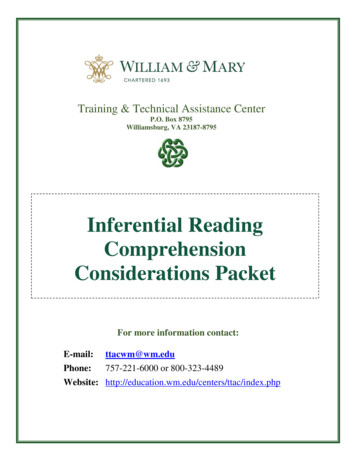
Transcription
Training & Technical Assistance CenterP.O. Box 8795Williamsburg, VA 23187-8795Inferential ReadingComprehensionConsiderations PacketFor more information contact:E-mail:ttacwm@wm.eduPhone:757-221-6000 or 800-323-4489Website: http://education.wm.edu/centers/ttac/index.php
Explicit Instruction for Implicit Meaning:Strategies for Teaching Inferential Reading ComprehensionThe No Child Left Behind Act of 2001 promotes use of scientifically based research to provide high-qualityreading instruction to help all students become successful readers. Comprehension is a key component of thisliteracy initiative; facility in literal, inferential, critical, and creative comprehension skills is critical to readingsuccess and academic achievement in all content areas. This packet focuses on research-based strategiesteachers may employ to improve students’ inferential comprehension skills. Topics include the meaning of theterm inferential comprehension, specific subskills necessary for making inferences, suggestions for teachingstudents to make inferences, and ideas for providing a variety of opportunities for students to practice the skillof inferential comprehension.IntroductionInferential comprehension is often described simply as the ability to read between the lines. It requires a readerto blend the literal content of a selection with prior knowledge, intuition, and imagination for conjecture or tomake hypotheses. Barrett’s Taxonomy of Reading Comprehension (1974) identifies the following eightsubtasks that enable students to make inferences with facility. Inferring supporting details – guessing about additional facts the authorcould have included in the selection that would have made it moreinformative, interesting, or appealing Inferring the main idea – providing the main idea, general significance,theme, or moral that is not explicitly stated in the selection Inferring sequence – guessing what action or incident might have takenplace between two explicitly stated actions or incidents or makinghypotheses about what could happen next Inferring comparisons – inferring likenesses and differences in characters,times, or places Inferring cause-and-effect relationships – hypothesizing about the motivesof characters and their interactions with others and with time and place Inferring character traits – hypothesizing about the nature of characters onthe basis of explicit clues presented in the selection Predicting outcomes – guessing the outcome of a selection after reading aninitial portion of it Inferring about figurative language – inferring literal meanings from theauthor’s figurative use of language.Stated differently, Keene and Zimmerman (1997) observed that when proficient readers infer, they:Considerations: Inferential ComprehensionT/TAC W&M20022
Draw conclusions from text Make reasonable predictions as they read, test and revise those predictions as they read further Create dynamic interpretations of text that are adapted as they continue to read Use the combination of background knowledge and explicitly stated information from the text to answerquestions they have as they read Make connections between conclusions they draw and other beliefs or knowledge Make critical or analytical judgments about what they readProficient readers are better able to remember and apply what they have read, create new backgroundknowledge for themselves, discriminate and critically analyze text and authors, and engage in conversationand/or other analytical responses to what they read.Conversely, struggling readers have difficulty with some or all of these comprehension skills. Fortunately, theresults of many studies associated with comprehension strategies (e.g., Lenz & Hughes, 1990; Scanlon, Deshler,& Shumaker, 1996; Shumaker, Deshler, Alley, Warner, & Denton, 1982) indicate that students with highincidence disabilities can learn to mediate their comprehension of reading material through intensive,systematic, and explicit instruction in learning strategies.Research conducted in the 1970s concluded that classroom teachers were spending very little time on the actualprocess of teaching reading comprehension. For example, Durkin (1978-1979) found that although teachersgave many workbook assignments and asked many questions about what students had read, these exercisesusually assessed students’ understanding rather than teaching them how to comprehend. In response to Durkin’sfindings, much subsequent research during the 1980s was devoted to discovering how to teach comprehensionstrategies directly. One widely researched model, explicit instruction, involves four phases: Teacher explanation and modeling of a strategy Guided practice during which teachers gradually give students more responsibility for task completion Independent practice accompanied by feedback Application of the strategy in real reading situations (Fielding & Pearson, 1994).Indeed, as Pearson and Duke (2002) point out, “Comprehension improves when teachers provide explicitinstruction in the use of comprehension strategies. Comprehension improves when teachers implement activitiesthat support the understanding of the text that students will read in their classes”(p. 247). The material that follows provides suggestions for introducing to students the concept of makinginferences and showcases strategies for explicit instruction of inferential comprehension skills.Considerations: Inferential ComprehensionT/TAC W&M20023
Correlation of Strategies to Barrett’s Taxonomy of Reading ComprehensionWhat Is It?Cucumber CuesBackwards WordsThink-AloudWho’s Who?QARLocal Fun and GamesCloze ProcedureDRTAReciprocal TeachingPicture This!Simple SentencesCartoon CommentarySequencing TextSequencing with MusicSequencing DirectionsDetectiveJustifying AnswersActing OutFigure It Out!Figurative Language AdsFigurative Language ArtworkGraphic OrganizersOpen MindPersonality TraitsConsiderations: Inferential ComprehensionT/TAC W&M2002 4
What is It? (Adapted from Reading Workshop, n. d.)1. Introduce an object with which students may be unfamiliar, for example, an apple corer. Ask them toinfer the object’s purpose.2. After several guesses, introduce a second object with which the first object is used; for example in thiscase, an apple. Continue to ask students to make inferences about the purpose of the first object.3. Show students how the first object is used with the second object – in other words, core the apple.4. Ask students who correctly guessed the purpose of the first object (the corer) to explain how theintroduction of the second object (the apple) helped them infer its purpose. Explain that usinginformation they already know can help students grasp the meaning of information they do not know.Other suggested object pairs follow. Show a nutcracker. Ask students to make an inference – for what is it used? After severalguesses, introduce an unshelled nut. Show an olive pitter. Ask students to make an inference – for what is it used? After severalguesses, introduce a bowl of olives.Cucumber Cues1. Provide students with sentences in which one word has been replaced by the word cucumber. (Theteacher may read each sentence to nonreaders.)2. Ask students to write or say the sentences, changing cucumber to a word that makes better sense.Examples follow.A. I like to eat peanut cucumber.B. Clean your cucumber with a toothbrush.C. A dog has four cucumbers.3. As students share their responses, ask them to identify words that gave them clues to the word theysubstituted. Ask students to relate the clue word to their background experiences and explain how thisbackground information helped them find an appropriate substitute word.Backwards Words1. Provide students with sentences in which one word is spelled backwards.2. Ask students to read or listen to each sentence, find the word that is spelled backwards, and write or sayit correctly. Examples follow.Considerations: Inferential ComprehensionT/TAC W&M20025
A. You are my lap.B. The cat was a man.C. The meat is in a nap.D. Look at the pam.E. Dad put sag in the car.F. Dogs are good step.3. As students share their responses, have them identify words that gave them clues to the word that wasspelled backwards. Ask students to relate the clue word to their background experiences and explainhow this background information helped them find the backwards word.Think-Aloud (Adapted from Readance, Bean, & Baldwin, 1989)The teacher reads aloud to students and verbalizes the thinking he or she is doing in order to make inferencesthat help the teacher comprehend the text. Specifically:1. Locate the evidence (stated facts) in the text from which one can reason.2. Think out loud, showing students how to put together prior knowledge and the facts from the text toanswer the question.3. Model the inferencing procedure until the students can begin to take over the necessary steps, finallyreasoning successfully on their own.By modeling this skill, normally invisible thought processes are made clear to students.For example, the teacher reads the following text:“Grizzly bears are found in western Canada and in Alaska, living in forests onmountain sides. They have shaggy fur, humped shoulders, sharp teeth and long,sharp claws Grizzlies usually live alone. Each bear has its own area of land,called a home range. It leaves scents on the bark of trees all the way around itshome range to let other bears know where it lives.” [Wood, J. (1989). My firstbook of animals (p. 34). Boston, MA: Little, Brown.]A portion of the teacher’s think-aloud might be as follows:“Humped shoulders? Hmmm. What do they mean by that? Oh, maybe whenthey’re down on all fours; yeah, their backs are kind of like a hump then,okay, I get it!”Who’s Who? (Adapted from Redance, Bean, & Baldwin, 1989)Share the following scenario with students.1. The manager, the accountant, the teller, and the auditor at our local bank are Mr. Smith, Mr.Brown, Mr. Jones, and Mr. Foster, not necessarily in that order. Mr. Brown is taller than the auditor or the teller.The manager lunches aloneMr. Jones plays bridge with Mr. Smith.Considerations: Inferential ComprehensionT/TAC W&M20026
The tallest of the four plays basketball.Mr. Foster lunches with the auditor and teller.Mr. Smith is older than the auditor.Mr. Brown plays no sports.2. Then ask, “Which job does each man perform?”3. Provide a chart such as the one below and use it to demonstrate the process by which the question maybe answered.First put circles in the squares to eliminatechoices. Then put an X when you find amatch.Mr. SmithMr. BrownMr. JonesMr. FosterQAR (Question–Answer Relationships) (Adapted from Raphael & Pearson, 1985)1. Use a small passage to construct questions of three types: Right There – questions that can be answered by simply locating the words in one sentence(literal comprehension) Think and Search – questions that can be found in the passage but not in one sentence(inferential comprehension) On My Own – questions that must be answered in the reader’s head(critical/creative comprehension)2. Have the students read the brief passage.3. Pose questions of the three types.Considerations: Inferential ComprehensionT/TAC W&M20027
4. Have students answer each question and identify the evidence in the passage (unless it is an OnMy Own question) and explain their reasoning.This teaching activity can involve manipulative materials by giving students cutouts of a human head andcutouts of a book. For each question, students lay out one or both cutouts to indicate the type of question beingasked.Right There – bookThink and Search – book and headOn My Own – headLocal Fun and Games (Adapted from ITP Web Solutions, 1999)1. Search local newspapers to find ads for entertainment in the surrounding area.2. On a map of the area, ask students to print the names of the entertainment places they identified in thenewspaper ads in the correct location.3. Ask students to identify the patterns that link centers of entertainment with the population.4. Ask students to predict where entertainment centers may be developed in the near future.Cloze Procedure (Adapted from Dewitz, Carr, & Patberg, 1989)When preparing cloze experiences, follow these two criteria for selecting words to delete: Delete words that are critical to understanding the text and, therefore, cause readers to focus onimportant concepts; Delete words whose position forces readers to search previous and ensuing text to infer answers thatrequire them to call upon their background knowledge.Begin in the following manner:1. Create a simple cloze statement by deleting one word from an informational sentence.2. Ask students to generate a list of words that would make sense in the cloze blank.Example: The truck skidded out of control, crashed through the railing, and fell over the .(cliff, bridge, road)Emphasize that readers rely primarily on previous knowledge to fill in the blanks when the authorprovides no obvious clues in the text.3. Invite readers to examine additional cloze examples in which clues to the possible missing word(s) areincluded in subsequent text and, in order for the sentence to make sense, a reader would need to read onand gather additional information to infer the missing word.Example: The truck skidded out of control, crashed through the railing, and fell over the .Since the boat was under the bridge, it missed being hit by the truck.Considerations: Inferential ComprehensionT/TAC W&M20028
As students become proficient at completing single cloze sentences and short passages, increase the length ofthe passages using the following procedure:1. Delete appropriate words from a written passage.2. Direct students to work through the passage in the following manner:A. Read through the entire passage to get an understanding of what it is about.B. Think through what is actually happening in each sentence in which a word is missing.C. Look back at previous sentences, picturing the action and locating words that help inunderstanding the author’s intent for the sentence in question.D. As the passage becomes more complete, reread it and change previous answers, whereappropriate.3. When students have completed the activity, have them share their answers and give reasons for theirchoices.Directed Reading and Thinking Activity (DRTA) (Adapted from Stauffer, 1969)DRTA is used to teach procedures for inferring information and justifying responses, as well as developingmetacognition and monitoring comprehension. Students draw on their prior knowledge and text information tohypothesize what the text is about. Students monitor their thinking by providing a rationale for their predictions.As students read the text, they either verify or change their predictions. In this way, inferential comprehensionand metacognition are practiced throughout the reading process. Steps in the DRTA process follow.Before:1. Predict – develop purposes for reading.Possible Questions:What do you think the story might be about?What do you think might happen next?Why do you think so? (relating prior knowledge to the problem or situation)During:2.Read – reason while reading (metacognition).The teacher sets amount to be read before assessment.3. Confirm – verify predictions.Possible Questions:Were you right?Has something been added to your information that rules out your prediction?Why won’t that work?Considerations: Inferential ComprehensionT/TAC W&M20029
After:4. Reevaluate – reexamine purposes for reading.Possible Questions:Is your idea still possible?Do you wish to change your prediction?What do you think will happen next?Note: Repeat steps 2-4, stopping at predetermined points, until the story is finished.5. Extend – refine.Extend concepts.Vary rates.Gather outside references.Redirect students’ thinking to a particular portion of the story.Add additional skill instruction, if needed.Reciprocal Teaching (Adapted from Palincsar & Brown, 1986)(This technique should be taught by having the teacher model each step until students can carry out the fourfunctions.)Direct students to work together, using a short, interesting passage to complete the four steps listed below.1. Students read a passage and ask each other questions about what they just read.2. Students summarize in one or two sentences what the passage was about (main idea).3. Students clarify what they did not understand, such as a vocabulary word, a phrase, or a statement, bydiscussing the material with their fellow group members.4. Students try to predict what will come next.Picture This! (Adapted from Reading Workshop, n. d.)1. Place piles of picture cards on tables.2. Organize students in partners.3. Ask each partner pair to draw a card and discuss what is implied or inferred by the picture.Examples of picture descriptions follow.A.B.C.D.E.A student yawns several times.Two students pass notes to one another.One student takes a pen from a classmate’s desk.A group of students has not completed homework.A student returns from recess crying.Considerations: Inferential ComprehensionT/TAC W&M200210
Simple Sentences (Adapted from Reading Workshop, n. d.)Give sentences to students to practice making inferences. Examples of sentences follow.A.B.C.D.E.Sue blew out the candles and opened her presents.John went running into the street without looking.We bought tickets and some popcorn.When I woke up, there were branches and leaves all over the yard.Yesterday we cleaned out or desks and took everything home.Cartoon Commentary (Adapted from ITP Web Solutions, n. d.)1. Provide editorial cartoons from recent copies of the local paper for students to examine. Encouragethem to notice how the cartoonist wants to influence their thinking, as well as make them chuckle.2. Ask students to think of a problem in their school about which they should be concerned.3. Instruct students to create their own editorial cartoons to show what they think about this schoolproblem.Sequencing Text (Adapted from In the Classroom, 2001)1. Select paragraphs or excerpts from books that describe a sequence of events or activities.2. Place one of the sentences in the paragraph out of order, and ask the students to find the sentence that isscrambled and makes the reading confused.3. Direct students to correct the position of the sentence so that the sequence makes sense.Variations: Students each hold a sentence strip and rearrange themselves in order. Students create sentence sequences based on something they know how to do (e.g., make amodel, wash a car) and ask peers to arrange them in chronological order.Sequencing with Music (Adapted from In the Classroom, 2001)1. After lessons on reading musical notation, give students sheet music on which notes of a familiar songhave been rearranged. Tell students that the notes on the page have been mixed up.2. Have students rearrange the notes in the sequence that produces the song that is familiar to them.Sequencing Directions (Adapted from In the Classroom, 2001)1. Select a routine school activity that is familiar to students, such as checking out materials in the libraryor using audiovisual equipment.2. Scramble one or several of the steps to accomplish the activity.3. Write the scrambled events or audiotape them (out of order).Considerations: Inferential ComprehensionT/TAC W&M200211
4. Ask students to read or listen to the events and identify what is out of order.5. Instruct students to reorder the written sequence or tape record a corrected version of the activity.Detective (Adapted from ITP Web Solutions, n. d.)1. Select a large city in the geographic region where you are located. Distribute copies of the city’s dailynewspaper to the class.2. Ask students to pretend that they have never been to this city and that all they know about it is what theycan learn from this one copy of the newspaper.3. Instruct students to scan the newspaper to find evidence that proves the city is large.4. Encourage students to compare their lists of evidence.Justifying Answers1. Pose a question that is not answered explicitly in a passage that students will read.2. Ask students to read the passage to answer the question.3. Direct students to write down their answers.4. Instruct students to go back to the passage to find words and ideas that support their answers.5. Have students discuss how the words and ideas they selected led to their answers.Acting Out (Adapted from The Topic: Figurative Language, n. d.)rhetorical usesimileriddleidiompersonification overstatementFigurative onomatopoeiaanalogyimageryidiomunderstatement overstatementproverbpersonification extended metaphor allegoryverbal picture figure of speechironyallusionsymbollanguageextended simile1. Ask small groups of students to select three phrases or sentences, each an example of a different type offigurative language (see chart above) such as, “You can’t teach an old dog new tricks.”2. Have each group act out its three phrases, using a video camera to record them.Considerations: Inferential ComprehensionT/TAC W&M200212
3. Provide an opportunity for each group to share its videos with other groups.Figure It Out!Instruct students to draw a “silly” picture showing what a given idiom seems to mean. Then write a sentenceexplaining what the idiom really means. Examples follow.A. We thought it was going to sprinkle, but it rained cats and dogs.B. Jose’ had such a bad cold that he coughed his head off.C. When Mary said my brother was stupid, I made her eat her words.Figurative Language Ads (Adapted from The Topic: Figurative Language, n. d.)1. Instruct students to create an ad for a new product that incorporates a form of figurative speech theyhave been studying (in the advertising text).2. Provide an opportunity for students to share their ads with classmates.Figurative Language Artwork (Adapted from The Topic: Figurative Language, n. d.)1. Have students select a figurative speech phrase such as, “That person is ‘as smart as a whip’” and createa drawing that illustrates it. Provide a place for students to display their artwork along with the phrasesthat accompany it.Variation: Have students find cartoons that depict figurative language.Graphic Organizers (National Institute of Child Health and Human Development, 2000).1. Select a passage with unstated relationships (without clues, such as time words).2. Have students read the passage.3. Instruct students in the process of arranging details in a graphic form using the appropriateorganizational pattern.Compare/ContrastSubject 1Cause/EffectCauseSubject 2EffectVenn DiagramSubject 1Subject rations: Inferential ComprehensionT/TAC W&M2002UniqueCharacteristics13
Open Mind (Adapted from Munroe, 2001)1. Prior to the lesson, create a handout that depicts the silhouette of a student’s head. Label the handout“Open Mind.” Create an overhead transparency of the same silhouette.2. Have students think of a book character with which the entire class is familiar. Ask students to identifywhat that character might have been thinking and/or feeling during one event from the story. Invitestudents to come to the overhead to draw symbols in the “open mind” to represent their responses.3. Read a new story aloud to the students.4. Ask students to identify the story’s main characters.5. Instruct students to select one of these characters and write his or her name on their copies of the “OpenMind” handout as it is distributed to each of them.6. Have students complete the “Open Mind” handout using symbols and words to depict the character’smotives and character traits. Ask them to make notes below their silhouettes to explain and support theirresponses.Personality Traits (Adapted from Munroe, 2001)1. Prior to the lesson draw on large chart paper a table that is labeled for names of characters in the far leftcolumn and personality traits across the top row.2. Have students name favorite characters from stories they have read, and state at least one trait thatdescribes each character. List these traits on the chalkboard or overhead projector. Then ask students toclassify each as either a physical descriptor or a personality descriptor.3. Tell students that they will listen to a story and identify the personality traits of characters in the story.Encourage students to take notes as they listen if that will help them to remember details of thecharacters.4. Read the story out loud.5. Ask students to identify several characters in the story, including the main character. List thesecharacters’ names on the left-hand column of the chart.6. Tell students to give personality descriptions of various characters in the story. List these descriptions inthe top row.7. Have students identify and discuss which of these traits each character has, and mark the row andcolumn for that character and trait with anConsiderations: Inferential ComprehensionT/TAC W&M200214
ConclusionIf students are to comprehend text, they must effectively use strategies that enable them to make inferences.Pearson and Johnson (1978) expressed this view succinctly in the following passage.Comprehension is building bridges between the new and theknown . Comprehension is active not passive; that is, thereader cannot help but interpret and alter what he reads inaccordance with prior knowledge about the topic underdiscussion. Comprehending is not simply a matter ofrecording and reporting verbatim what has been read.Comprehension involves a great deal of inference making. (p.24)A teacher’s thoughtful consideration of strategies to teach explicitly inferencing skills is critical to the academicachievement of students who struggle to comprehend.ReferencesBarrett, T. C., & Smith, R. (1974). Teaching reading in the middle. Reading, PA: Addison Wesley.Dewitz, P., Carr, E., & Patberg, J. (1989). Using cloze for inference training with expository text. TheReading Teacher, 42, 380-385.Durkin, D. (1978-1979). What classroom observations reveal about reading comprehension instruction.Reading Research Quarterly, 15, 481-533.Fielding, L. G. & Pearson, P. D. (1994). Reading comprehension: What works. EducationalLeadership, 51(5), 62-66.ITP Web Solutions. (1999). Learning resources. Retrieved July 17, 2002, card55.htmlIn the Classroom. (2001). Sample lessons and activities – Sequencing. Retrieved July 29, 2002, esequence.htmlKeene, E. O., & Zimmerman, S. (1997) Mosaic of thought: Teaching reading comprehension in areader’s workshop. Portsmouth, NH: Heinemann.Lenz, B. K., & Hughes, C. (1990). A word identification strategy for adolescents with learningdisabilities. Journal of Learning Disabilities, 23(3), 149-158.Munroe, M. B. (2001). Reading instructional standards. Teaching and Learning to Standards.Retrieved July 16, 2002, chres/instructionalstrategies.pdfNational Institute of Child Health and Human Development (2000). Report of the National ReadingPanel. Teaching Children to Read: An Evidence-Based Assessment of the Scientific Research Literatureon Reading and Its Implications for Reading Instruction: Reports of the Subgroups (NIH Publication No.00-4754). Washington, DC: U.S. Government Printing Office.Palinscar, A. S., & Brown, A. L. (1986). Interactive teaching to promote independent reading fromtext. Reading Teacher, 39(8), 771-777).Pearson, P. D., & Duke, N. K. (2002). Comprehensive instruction in the primary grades. In C.Collins-Block & M. Pressley (Eds.), Comprehensive instruction: Research-based best practices(pp. 247-258). New York: Guilford Press.Pearson, P. D., & Johnson, D. (1978). Teaching reading comprehension. New York: Holt, Rinehart &Winston.Considerations: Inferential ComprehensionT/TAC W&M200215
Raphael, T. E., & Pearson, P. D. (1985). Increasing students’ awareness of sources of information foranswering comprehension questions. American Educational Research Journal, 22, 217-236.Readance, J. E., Bean, T. W., & Baldwin, R. S. (1989). Content area reading (3rd ed.). Dubuque, IA:Kendall/Hunt.Reading Workshop. (n.d.). Inferring. Retrieved July 15, 2002, nguagearts/readingwriting/readinfer.htmlScanlon, D., Deshler, D. D., & Shumaker, J. B. (1996). Can a strategy be taught and learned insecondary inclusive classrooms? Learning Disabilities Research and Practice, 11(1), 41-57.Shumaker, J. B., Deshler, D. D., Alley, G. R., Warner, M. M., & Denton, P. H. (1982). Multipass: Alearning strategy for improving reading comprehension. Learning Disability Quarterly, 5(3), 295-304.Stauffer, R. G. (1969). Directing reading maturity as a cognitive process. New York: Harper & Row.The Topic: Figurative Language. (n.d.). Retrieved July 29, 2002 Additional ResourcesResources on inferential comprehension are available for loan through the T/TAC W&M library. Visit ourwebsite at http://education.wm.edu/centers/ttac/index.php for a complete listing of all materials. Select theLibrary link on the home page and enter reading comprehension as the subject of the search.This Considerations Packet was prepared by Dale Pennell, July 2002.Considerations: Inferential ComprehensionT/TAC W&M200216
reading instruction to help all students become successful readers. Comprehension is a key component of this literacy initiative; facility in literal, inferential, critical, and creative comprehension skills is critical to reading success and academic achievement in all conten
